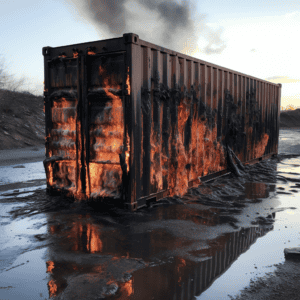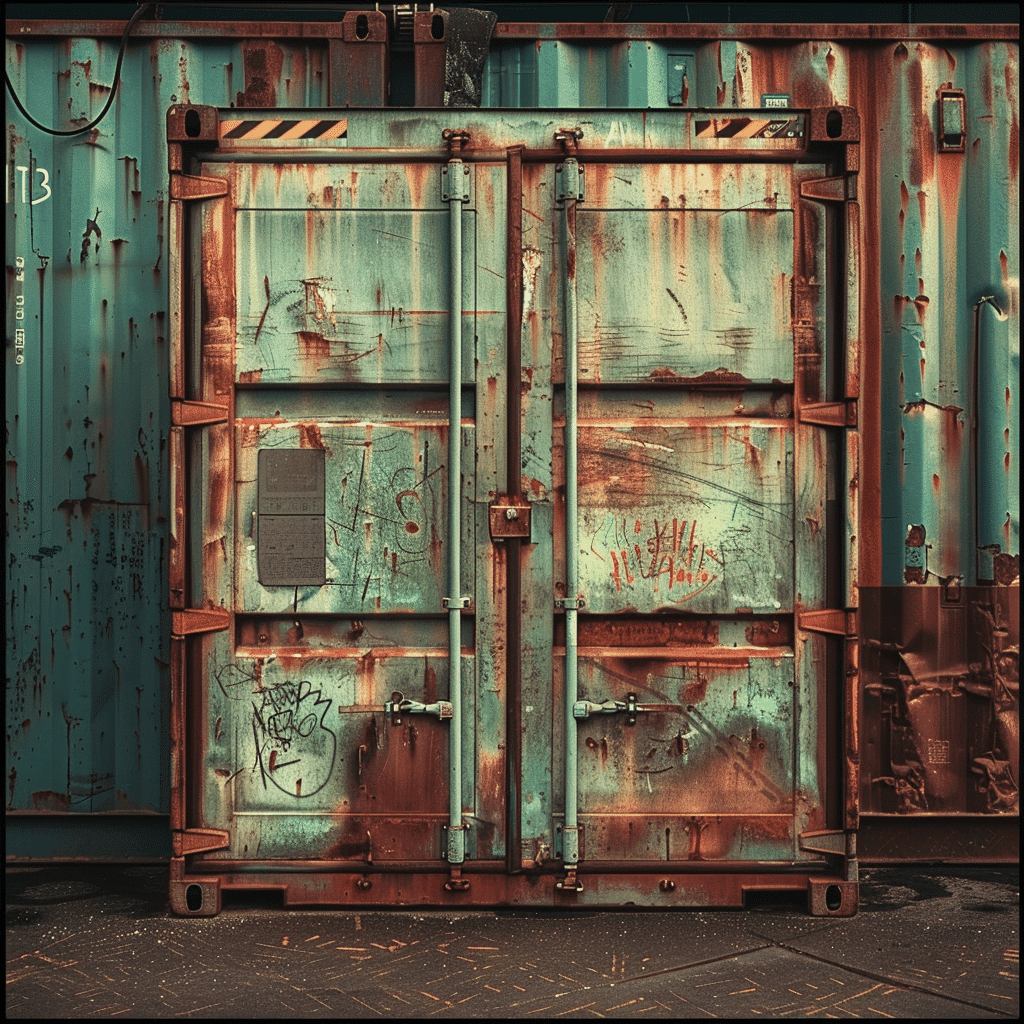You’ve probably seen countless shipping containers and may have wondered about their durability, specifically, are they fireproof?
Standard steel shipping containers aren’t entirely fireproof, but they’re highly fire-resistant. This resistance comes from their material, steel, which can withstand high temperatures. However, it’s important to remember that fire safety is still paramount. If exposed to prolonged, intense heat, even these containers can succumb to fire hazards.
Can Custom Shipping Containers Withstand Fire?
While standard shipping containers can resist fire to some extent, you might be wondering if custom ones offer even better protection.
Custom shipping containers are often modified, potentially affecting their fire resistance. However, if these modifications incorporate fire-resistant materials, they can withstand fire even better than standard containers.
The key is that these containers are fireproofed during the modification process.
For example, installing fire-resistant insulation or using fire retardant paint can minimize container fires. This makes the containers fireproof, thus enhancing their ability to withstand fire.

Discussion on the Materials Used in Manufacturing Shipping Containers
Considering the materials used in crafting shipping containers, you’ll find that they’re primarily made of steel, a material known for its exceptional fire resistance. More specifically, the manufacturer often uses marine-grade corten steel, which boasts superior durability and longevity.
These containers aren’t just about strength though. Fire protection is a key aspect of their construction. The steel structure can contain a fire, keeping flammable materials inside from igniting. This feature makes them a safe storage container option.
However, remember that while steel can resist heat, it’s not completely fireproof. It can warp under extreme temperatures. Still, the materials used provide a considerable level of protection, making shipping containers a wise choice for storing valuable goods.
Analysis of the Fireproof Nature of High-Grade Steel Used in Containers
When it comes to the fireproof properties of high-grade steel used in shipping containers, one must understand that it’s not entirely invulnerable to fire. Now, don’t panic, these containers can resist fire, but only up to a point.
Our analysis reveals that high-grade steel can withstand high temperatures, maintaining its structure up to 1500°F. But, if the fire’s temperature rises above this, the steel may start to warp or even melt.
It’s also worth noting that the contents inside the containers can influence the fireproof nature. Materials that are combustible might compromise the steel’s integrity faster.
Importance of Researching Manufacturers for Fire Safety Compliance
Despite the inherent fire-resistant qualities of high-grade steel, it’s absolutely crucial for you to research your shipping container’s manufacturer for compliance with fire safety standards. This isn’t just about whether the containers are fireproof. It’s about ensuring safety during the transportation and storage of flammable liquids or other hazardous materials.
Fire prevention measures, like the use of fire retardant foam, should be a top priority. So, when you’re researching manufacturers, check if they’re dedicated to fire safety compliance. Do they use fire-resistant materials? Do they implement fire safety measures in their production process? How are they contributing to fire prevention?
Measures You Can Take to Prevent Fires
You can take several steps to enhance the fire resistance of your shipping containers, ensuring they’re as safe as possible.
The first measure is to safely store combustible materials. Keep these materials far from the container or within a designated, fireproof area. This way, you can prevent fires from starting and spreading.
Next, consider the ventilation of your shipping containers. Proper ventilation reduces the chance of a fire by minimizing heat build-up. It also allows any flammable vapors to dissipate, rendering them less likely to ignite.
Regularly inspecting your containers for signs of rust or damage can also help. Remember, even though shipping containers are generally fire-resistant, they’re not completely fireproof. Your active involvement is crucial to maintain their safety.
Strategies for Eliminating Fire Hazards in and Around Shipping Containers
While it’s essential to take preventive measures, there are also specific strategies you can implement to eliminate potential fire hazards both inside and around your shipping containers. Firstly, ensure proper ventilation in your containers to discourage heat buildup. Store flammable materials correctly and avoid overloading electrical outlets.
Secondly, maintain clear access around containers. A clutter-free area minimizes the chances of a fire spreading. General storage container care and maintenance is always a good idea when it comes to minimizing fire safety risks.
Thirdly, install contextually relevant fire prevention systems like smoke detectors, sprinklers, or fire extinguishers. Regular inspections for potential fire hazards are also crucial.
Lastly, consider professional training for handling shipping containers. Knowledge is power in this context. Speaking of knowledge, it’s also important to know what you can and can’t store in a shipping container.
In this article section, we’ve outlined strategies for eliminating fire hazards in and around shipping containers. Implement them conscientiously to boost your container’s fire safety.
Identifying and Removing Common Fire Hazards
Often, it’s crucial that you’re able to identify and promptly remove common fire hazards to ensure your shipping container remains safe. An internal fire can be caused by heat transfer from items like lithium batteries, which are known to overheat and ignite. Keep an eye out for these and make sure they’re properly stored.
Spray foam, while useful for insulation, can also be a fire hazard if it comes into contact with flames. It’s not entirely fireproof and can contribute to a fire inside the container. Regularly check these materials and ensure they’re safely kept away from potential sources of heat.
Importance of Regular Inspections for Fire Safety
To uphold the fireproof nature of your shipping container, it’s vital that you conduct regular safety inspections. These inspections ensure the corten steel, known for its fireproof properties, hasn’t deteriorated due to high temperatures or smoke damage. Regular inspections also verify the heat insulation, integral for maintaining the container’s fireproof nature, is intact and functioning properly.
Shipping containers are designed to withstand harsh conditions, but without consistent checks, fire safety can be compromised. Remember, regular inspections aren’t just about meeting regulations; they’re a proactive measure to guard against potential fire hazards.
Don’t overlook the importance of this step in maintaining the fire safety of your shipping container. After all, it’s better to prevent damage than to fix it.

Educating Employees About Fire Safety
Regularly educating your employees about fire safety is another crucial step in maintaining the fireproof status of your shipping containers. You see, while the galvanized steel structure of these containers is fireproof, the insulation may not be. If a fire starts inside, it can quickly spread, compromising the safe environment. Therefore, employees should be well-versed in fire safety measures.
Educating employees about the correct usage and storage of flammable materials, and proper evacuation procedures, can make a significant difference. It’s also necessary to teach them about the unique properties of shipping containers. For instance, they need to understand that although made of fireproof material, the internal structure can still ignite under specific conditions. This knowledge can help prevent incidents, ensuring a safer workspace.
Best Practices for Fire Prevention in the Workplace
Valtran storage containers for rent or for sale are ideal for business use. In your efforts to maintain the fireproof status of your shipping containers, adopting certain proactive fire prevention strategies can help ensure a safer working environment. Start by understanding the best practices for fire prevention in the workplace. Use your sense of caution to guide you through this process.
Regularly inspect the equipment to spot any potential fire threats. If you find something amiss, don’t hesitate to modify your procedures to reduce risk. Invest in quality fire prevention equipment and ensure it’s in top working condition. Always be prepared for emergencies by having a clear evacuation plan. Encourage open communication among employees about fire safety. Remember, prevention is the best form of protection.
Training in the Use of Fire Extinguishers and Other Safety Equipment
For your fire prevention strategy, you must be well-trained in the use of fire extinguishers and other safety equipment. Training can make the difference between a minor incident and a catastrophic event.
It’s not enough to have fireproof shipping containers; knowing how to use safety equipment is a crucial part of your protective measures. The risk of fire is always present, and being prepared can save lives and protect your assets.
You should learn how to properly use a fire extinguisher, understand when it’s appropriate to use, and know the different types that exist. Don’t underestimate the importance of training.
In the face of a fire, it’s your actions that matter most.
Frequently Asked Questions
How Much Heat Can a Shipping Container Withstand?
Shipping containers are designed to withstand a wide range of temperatures, making them suitable for various environments and weather conditions. Studies have shown that the maximum temperature inside a shipping container can reach up to 135 degrees Fahrenheit (about 57 degrees Celsius). This high level of heat tolerance is particularly important considering that shipping containers are often exposed to direct sunlight, which can significantly increase their internal temperature.
The metal construction of these containers contributes to their ability to absorb and retain heat. However, it’s important to note that while they can withstand high temperatures, the internal conditions can become quite hot, which might affect the contents if not properly managed or insulated. This resilience to high temperatures underscores the versatility and durability of shipping containers in different climatic conditions.
Is a Container Fire Proof?
Shipping containers are highly fire-resistant, primarily due to their construction from galvanized steel. This material not only makes the containers tough and weather-proof but also enables them to withstand high temperatures and resist fire.
While they are not entirely fireproof, their design and material significantly enhance their ability to resist fire, making them a reliable choice for various uses where fire resistance is a concern. This fire-resistant quality of shipping containers adds to their versatility, making them suitable for a wide range of applications, including storage and construction, where fire safety is a priority.
What Temperature Does a Container Fire Burn At?
Determining the exact temperature at which a container fire burns can be complex, as it largely depends on the materials involved in the fire and the specific conditions of the container. However, it’s noted that the average forest fire, which can be a reference for outdoor fire scenarios, burns at around 1,472°F (800°C).
This temperature indicates the intensity of a fire that a shipping container might be exposed to in extreme conditions. The materials within the container, the container’s construction, and the surrounding environment all play a role in how the fire develops and the temperatures it reaches. This information is crucial for understanding the resilience of shipping containers in fire situations and for planning appropriate fire safety measures.
Conclusion
Remember, while shipping containers are durable and their steel walls can withstand heat, they’re not entirely fireproof. The contents inside can still be damaged by intense heat, despite the exterior’s resistance.
It’s essential to implement fire safety measures and have firefighters on standby during shipping. Regularly inspect and maintain the containers to prevent any potential fire hazards.
Also, provide training on how to handle emergencies. Always prioritize the safety of your personnel and assets.
With these precautions, you can better protect your shipping containers and their contents against fire damage.


